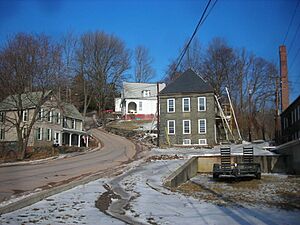White Mills, Pennsylvania facts for kids
Quick facts for kids
White Mills, Pennsylvania
|
|
|---|---|
| Village of White Mills | |

A 2008 view of White Mills Road, showing the Dorflinger factory office and factory at the right. The Dorflinger buildings have now been restored.
|
|
| Nickname(s):
White's Mills
|
|

Location in Wayne County and the state of Pennsylvania.
|
|
| Country | United States |
| State | Pennsylvania |
| U.S. Congressional District | PA-10 |
| School Districts | Wayne Highlands (Region III) Wallenpaupack Area |
| County | Wayne |
| Magisterial District | 22-3-02 |
| Township | Texas |
| Area | |
| • Total | 1.517 sq mi (3.927 km2) |
| • Land | 1.483 sq mi (3.840 km2) |
| • Water | 0.034 sq mi (0.087 km2) |
| Elevation | 948 ft (289 m) |
| Population
(2010)
|
|
| • Total | 659 |
| • Density | 444/sq mi (172/km2) |
| Time zone | UTC-5 (Eastern (EST)) |
| • Summer (DST) | UTC-4 (Eastern Daylight (EDT)) |
| ZIP code |
18473
|
| Area code(s) | 570 |
| GNIS feature IDs | 1191289 (Village) 2631315 (CDP) |
| FIPS code | 42-84696 |
| Major Roads | |
| Waterways | Butcher Pond, Lackawaxen River |
White Mills is a small village in Pennsylvania, United States. It is located in Texas Township, which is part of Wayne County. In 2010, the village had a population of 659 people. You can find White Mills along U.S. Route 6 in the eastern part of Wayne County.
Template:TOC limit=3
Contents
The History of White Mills
White Mills has a long and interesting history. It started with early settlers and grew into a special place known for glassmaking.
Early Settlements and Sawmills
In 1803, a man named Jonathan Brink bought land near White Mills. He built one of the first sawmills there. This mill helped to cut wood for building homes and other structures.
Around 1823, another sawmill was built on the Lackawaxen River. This area was not very populated back then. The new mill was built for a company from Philadelphia. All the buildings for this mill were painted white. This is how the village got its name, "White Mills."
The Dorflinger Glass Company
A very important part of White Mills' history began in 1865. A French immigrant named Christian Dorflinger opened a glass factory. He had already started a successful glass company in Brooklyn, New York. But he wanted to build a new factory and a company town in White Mills. He wanted to get away from the pollution and problems in New York City.
In White Mills, Dorflinger and his sons built a huge factory. They also built over one hundred houses for their workers and their families. Many skilled glassmakers from Europe came to live and work in White Mills.
Famous Glassware from White Mills
The Dorflinger Glass Company made beautiful cut lead crystal. This special glass was used in the White House for presidents like Abraham Lincoln and Benjamin Harrison. It was also used for important events, such as the weddings of famous people like William Kissam Vanderbilt II.
The Factory's End and New Beginning
The glass factory kept making glass until 1921. It had to close because of new laws about alcohol (Prohibition) and problems getting materials. When the factory closed, many people left White Mills.
However, the story didn't end there. In 2017, the old Dorflinger Glass Factory buildings were fixed up. They are now a museum where people can learn about the village's amazing glassmaking past.
Geography of White Mills
White Mills is a small area. It covers about 1.5 square miles (3.9 square kilometers). Most of this area is land. A small part, about 2.2%, is water.
Population and People
In 2010, White Mills had 659 residents. There were 280 households in the village. The population density was about 444 people per square mile.
The people living in White Mills come from different backgrounds. Most residents are White. There are also smaller groups of African American, Native American, and Asian people. Some residents are also of Hispanic or Latino heritage.
The average age of people in White Mills in 2010 was about 45 years old. This means it's a community with a mix of younger and older residents.
See also
 In Spanish: White Mills para niños
In Spanish: White Mills para niños


